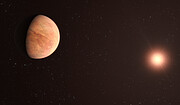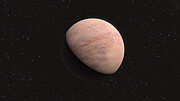Press Release
New ESO observations show rocky exoplanet has just half the mass of Venus
5 August 2021
A team of astronomers have used the European Southern Observatory’s Very Large Telescope (ESO’s VLT) in Chile to shed new light on planets around a nearby star, L 98-59, that resemble those in the inner Solar System. Amongst the findings are a planet with half the mass of Venus — the lightest exoplanet ever to be measured using the radial velocity technique — an ocean world, and a possible planet in the habitable zone.
"The planet in the habitable zone may have an atmosphere that could protect and support life,” says María Rosa Zapatero Osorio, an astronomer at the Centre for Astrobiology in Madrid, Spain, and one of the authors of the study published today in Astronomy & Astrophysics.
The results are an important step in the quest to find life on Earth-sized planets outside the Solar System. The detection of biosignatures on an exoplanet depends on the ability to study its atmosphere, but current telescopes are not large enough to achieve the resolution needed to do this for small, rocky planets. The newly studied planetary system, called L 98-59 after its star, is an attractive target for future observations of exoplanet atmospheres. Its orbits a star only 35 light-years away and has now been found to host rocky planets, like Earth or Venus, which are close enough to the star to be warm.
With the contribution of ESO’s VLT, the team was able to infer that three of the planets may contain water in their interiors or atmospheres. The two planets closest to the star in the L 98-59 system are probably dry, but might have small amounts of water, while up to 30% of the third planet’s mass could be water, making it an ocean world.
Furthermore, the team found “hidden” exoplanets that had not previously been spotted in this planetary system. They discovered a fourth planet and suspect there is a fifth, in a zone at the right distance from the star for liquid water to exist on its surface. “We have hints of the presence of a terrestrial planet in the habitable zone of this system,” explains Olivier Demangeon, a researcher at the Instituto de Astrofísica e Ciências do Espaço, University of Porto in Portugal and lead author of the new study.
The study represents a technical breakthrough, as astronomers were able to determine, using the radial velocity method, that the innermost planet in the system has just half the mass of Venus. This makes it the lightest exoplanet ever measured using this technique, which calculates the wobble of the star caused by the tiny gravitational tug of its orbiting planets.
The team used the Echelle SPectrograph for Rocky Exoplanets and Stable Spectroscopic Observations (ESPRESSO) instrument on ESO’s VLT to study L 98-59. “Without the precision and stability provided by ESPRESSO this measurement would have not been possible,” says Zapatero Osorio. “This is a step forward in our ability to measure the masses of the smallest planets beyond the Solar System.”
The astronomers first spotted three of L 98-59’s planets in 2019, using NASA’s Transiting Exoplanet Survey Satellite (TESS). This satellite relies on a technique called the transit method — where the dip in the light coming from the star caused by a planet passing in front of it is used to infer the properties of the planet — to find the planets and measure their sizes. However, it was only with the addition of radial velocity measurements made with ESPRESSO and its predecessor, the High Accuracy Radial velocity Planet Searcher (HARPS) at the ESO La Silla 3.6-metre telescope, that Demangeon and his team were able to find extra planets and measure the masses and radii of the first three. “If we want to know what a planet is made of, the minimum that we need is its mass and its radius,” Demangeon explains.
The team hopes to continue to study the system with the forthcoming NASA/ESA/CSA James Webb Space Telescope (JWST), while ESO’s Extremely Large Telescope (ELT), under construction in the Chilean Atacama Desert and set to start observations in 2027, will also be ideal for studying these planets. “The HIRES instrument on the ELT may have the power to study the atmospheres of some of the planets in the L 98-59 system, thus complementing the JWST from the ground,” says Zapatero Osorio.
“This system announces what is to come,” adds Demangeon. “We, as a society, have been chasing terrestrial planets since the birth of astronomy and now we are finally getting closer and closer to the detection of a terrestrial planet in the habitable zone of its star, of which we could study the atmosphere.”
More information
This research was presented in a paper entitled “A warm terrestrial planet with half the mass of Venus transiting a nearby star” to appear in Astronomy & Astrophysics (doi: 10.1051/0004-6361/202140728).
The team is composed of Olivier D. S. Demangeon (Instituto de Astrofísica e Ciências do Espaço, Universidade do Porto, Portugal [IA/UPorto], Centro de Astrofísica da Universidade do Porto, Portugal [CAUP] and Departamento de Física e Astronomia, Faculdade de Ciências, Universidade do Porto, Portugal [FCUP]), M. R. Zapatero Osorio (Centro de Astrobiología, Madrid, Spain [CSIC-INTA]), Y. Alibert (Physics Institute, University of Bern, Switzerland [Bern]), S. C. C. Barros (IA/UPorto, CAUP and FCUP), V. Adibekyan (IA/UPorto, CAUP and FCUP), H. M. Tabernero (IA/UPorto and CAUP), A. Antoniadis-Karnavas (IA/UPorto & FCUP), J. D. Camacho (IA/UPorto & FCUP), A. Suárez Mascareño (Instituto de Astrofísica de Canarias, Tenerife, Spain [IAC] and Departamento de Astrofísica, Universidad de La Laguna, Tenerife, Spain [ULL]), M. Oshagh (IAC/ULL), G. Micela (INAF – Osservatorio Astronomico di Palermo, Palermo, Italy), S. G. Sousa (IA/UPortol & CAUP), C. Lovis (Observatoire de Genève, Université de Genève, Geneva, Switzerland [UNIGE]), F. A. Pepe (UNIGE), R. Rebolo (IAC/ULL & Consejo Superior de Investigaciones Científicas, Spain), S. Cristiani (INAF – Osservatorio Astronomico di Trieste, Italy [INAF Trieste]), N. C. Santos (IA/UPorto, CAUP and FCUP), R. Allart (Department of Physics and Institute for Research on Exoplanets, Université de Montréal, Canada and UNIGE), C. Allende Prieto (IAC/ULL), D. Bossini (IA/UPorto), F. Bouchy (UNIGE), A. Cabral (Instituto de Astrofísica e Ciências do Espaço, Faculdade de Ciências da Universidade de Lisboa, Portugal [IA/FCUL] and Departamento de Física da Faculdade de Ciências da Universidade de Lisboa, Portugal), M. Damasso (INAF – Osservatorio Astrofisico di Torino, Italy [INAF Torino]), P. Di Marcantonio (INAF Trieste), V. D’Odorico (INAF Trieste & Institute for Fundamental Physics of the Universe, Trieste, Italy [IFPU]), D. Ehrenreich (UNIGE), J. Faria (IA/UPorto, CAUP and FCUP), P. Figueira (European Southern Observatory, Santiago de Chile, Chile [ESO-Chile] and IA/UPorto), R. Génova Santos (IAC/ULL), J. Haldemann (Bern), J. I. González Hernández (IAC/ULL), B. Lavie (UNIGE), J. Lillo-Box (CSIC-INTA), G. Lo Curto (European Southern Observatory, Garching bei München, Germany [ESO]), C. J. A. P. Martins (IA/UPorto and CAUP), D. Mégevand (UNIGE), A. Mehner (ESO-Chile), P. Molaro (INAF Trieste and IFPU), N. J. Nunes (IA/FCUL), E. Pallé (IAC/ULL), L. Pasquini (ESO), E. Poretti (Fundación G. Galilei – INAF Telescopio Nazionale Galileo, La Palma, Spain and INAF – Osservatorio Astronomico di Brera, Italy), A. Sozzetti (INAF Torino), and S. Udry (UNIGE).
ESO is the foremost intergovernmental astronomy organisation in Europe and the world’s most productive ground-based astronomical observatory by far. It has 16 Member States: Austria, Belgium, Czechia, Denmark, France, Finland, Germany, Ireland, Italy, the Netherlands, Poland, Portugal, Spain, Sweden, Switzerland and the United Kingdom, along with the host state of Chile and with Australia as a Strategic Partner. ESO carries out an ambitious programme focused on the design, construction and operation of powerful ground-based observing facilities enabling astronomers to make important scientific discoveries. ESO also plays a leading role in promoting and organising cooperation in astronomical research. ESO operates three unique world-class observing sites in Chile: La Silla, Paranal and Chajnantor. At Paranal, ESO operates the Very Large Telescope and its world-leading Very Large Telescope Interferometer as well as two survey telescopes, VISTA working in the infrared and the visible-light VLT Survey Telescope. Also at Paranal ESO will host and operate the Cherenkov Telescope Array South, the world’s largest and most sensitive gamma-ray observatory. ESO is also a major partner in two facilities on Chajnantor, APEX and ALMA, the largest astronomical project in existence. And on Cerro Armazones, close to Paranal, ESO is building the 39-metre Extremely Large Telescope, the ELT, which will become “the world’s biggest eye on the sky”.
Links
- Research paper
- Photos of the VLT
- For journalists: subscribe to receive our releases under embargo in your language
- For scientists: got a story? Pitch your research
Contacts
Olivier Demangeon
Instituto de Astrofisica e Ciências do Espaço, Faculdade de Ciências, Universidade do Porto
Porto, Portugal
Tel: +351 226 089 855
Email: olivier.demangeon@astro.up.pt
María Rosa Zapatero Osorio
Chair of the “Atmospheric Characterisation” working group of the ESPRESSO science team at Centro de Astrobiología (CSIC-INTA)
Madrid, Spain
Tel: +34 9 15 20 64 27
Email: mosorio@cab.inta-csic.es
Nuno Santos
Instituto de Astrofisica e Ciências do Espaço, Faculdade de Ciências, Universidade do Porto
Porto, Portugal
Email: nuno.santos@astro.up.pt
François Bouchy
Member of the “Transiting planets” working group of the ESPRESSO science team at Université de Genève
Genève, Switzerland
Tel: +41 22 379 24 60
Email: Francois.Bouchy@unige.ch
Alejandro Suárez Mascareño
Instituto de Astrofísica de Canarias
Tenerife, Spain
Tel: +34 658 778 954
Email: asm@iac.es
Mario Damasso
INAF – Osservatorio Astrofisico di Torino
Turin, Italy
Tel: +39 339 1816786
Email: mario.damasso@inaf.it
Pedro Figueira
Astronomer at ESO and Instituto de Astrofísica e Ciências do Espaço, instrument scientist of ESPRESSO
Santiago, Chile
Tel: +56 2 2463 3074
Email: pedro.figueira@eso.org
Bárbara Ferreira
ESO Media Manager
Garching bei München, Germany
Tel: +49 89 3200 6670
Cell: +49 151 241 664 00
Email: press@eso.org
About the Release
| Release No.: | eso2112 |
| Name: | L 98-59 |
| Type: | Milky Way : Star : Circumstellar Material : Planetary System |
| Facility: | Very Large Telescope |
| Instruments: | ESPRESSO |
| Science data: | 2021A&A...653A..41D |







